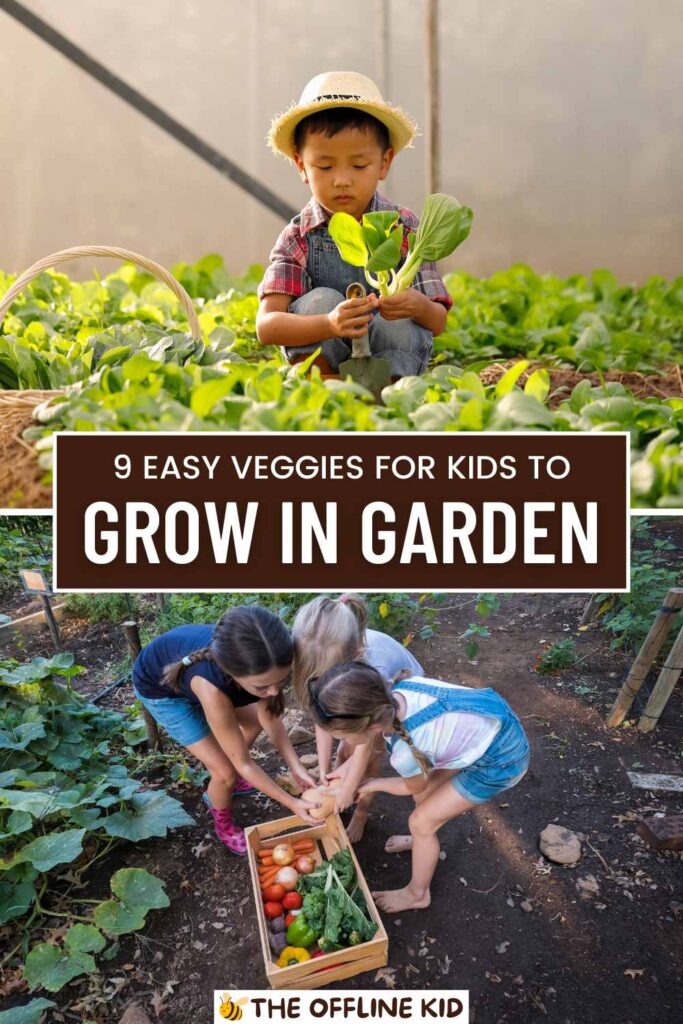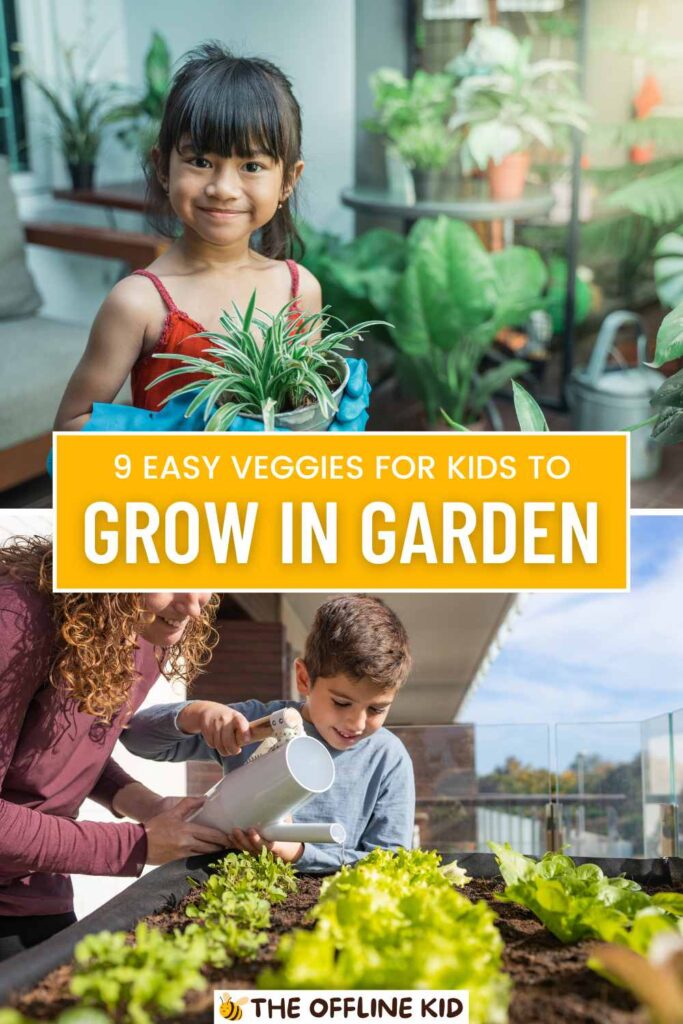Welcome to the ultimate guide on the easiest veggies to garden for kids!
Discover simple, fun ways to introduce your children to gardening and help them grow their own vegetables.
Getting Started with Gardening
Choosing the Right Spot
- Sunlight: Ensure the garden area gets at least 6-8 hours of sunlight daily. Most vegetables thrive in full sun.
- Soil Conditions: Select a spot with well-drained soil. You can improve soil quality by adding compost or organic matter.
- Space Considerations: Whether you have a large backyard or a small balcony, you can create a garden. Use raised beds or containers if space is limited.
Basic Gardening Tools for Kids
- Kid-Friendly Gardening Tools: Invest in small, lightweight tools like trowels, rakes, and watering cans designed for children. These tools are easier for little hands to manage.
- Safety Tips:
- Supervise young children while they use gardening tools.
- Teach kids to store tools properly to avoid accidents.
- Encourage wearing gloves to protect hands from dirt and potential hazards.
Preparing the Garden
Soil Preparation
- Testing Soil Quality: Use a soil test kit to check pH levels and nutrient content. Most veggies prefer slightly acidic to neutral soil (pH 6.0-7.0).
- Adding Compost and Nutrients: Enrich the soil with compost or well-rotted manure to improve fertility and structure.
- Creating Raised Beds or Container Gardens: Raised beds can be easier for kids to manage and can prevent soil compaction. Containers are perfect for small spaces and can be moved as needed.
Planning the Garden Layout
- Deciding Which Vegetables to Plant: Choose easy-to-grow vegetables that will give kids quick results and satisfaction.
- Companion Planting Tips: Some plants grow better together. For example, planting basil with tomatoes can improve flavor and repel pests.
- Making a Garden Map: Draw a simple plan showing where each vegetable will be planted. This helps kids visualize the garden and understand plant spacing.
This foundational section sets the stage for a successful gardening experience by helping you choose the right location, gather essential tools, and prepare the garden for planting.
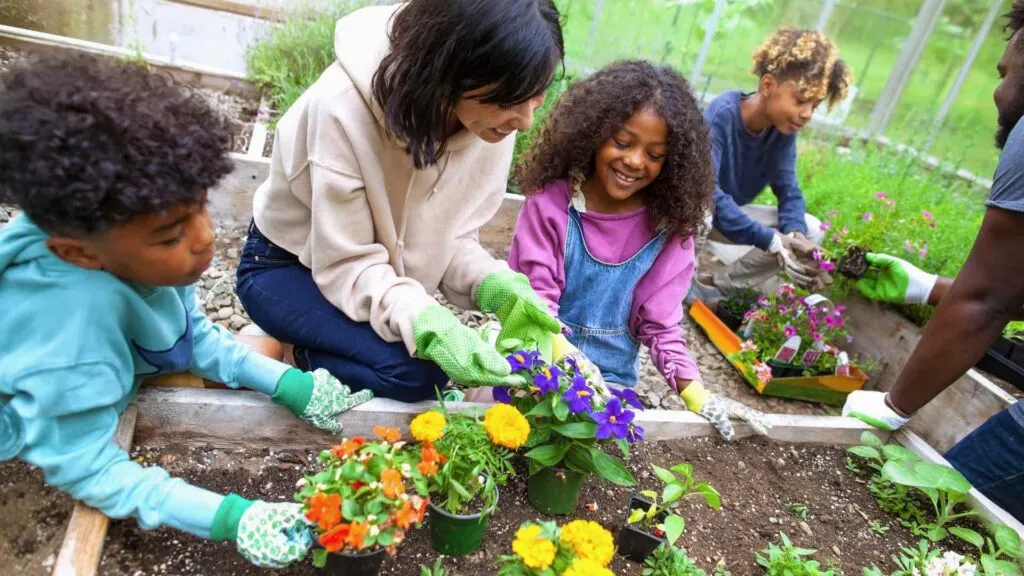
Easy Vegetables to Grow
Radishes
- Quick Growth Cycle: Radishes are one of the fastest-growing vegetables, ready to harvest in as little as 3-4 weeks.
- Simple Planting and Care Tips: Plant radish seeds directly into the soil about 1 inch apart. Water regularly to keep the soil moist.
- Harvesting Fun for Kids: Kids will love pulling these colorful veggies out of the ground. Harvest when the radishes are about 1 inch in diameter.
Carrots
- Best Varieties for Kids: Choose short or round varieties like ‘Thumbelina’ or ‘Paris Market’ which are easier to grow in different soil types.
- Planting and Thinning Techniques: Sow seeds thinly in rows, then thin seedlings to 2 inches apart to give them space to grow.
- Engaging Kids in the Harvesting Process: Carrots can take 2-3 months to mature. Let kids pull up these sweet and crunchy treats when the tops are about 1 inch wide.
Lettuce
- Fast-Growing Leafy Greens: Lettuce varieties like ‘Buttercrunch’ and ‘Romaine’ are quick to grow and can be harvested multiple times.
- Different Types of Lettuce to Try: Experiment with leaf, romaine, and butterhead lettuces for variety.
- Continuous Harvesting Methods: Teach kids to harvest the outer leaves first, allowing the inner leaves to continue growing for a prolonged harvest.
Snap Peas
- Climbing and Bush Varieties: Choose from climbing varieties that need support or bush varieties that are more compact.
- Easy Planting and Maintenance: Plant seeds about 1 inch deep and 2 inches apart. Water consistently and provide support for climbing types.
- Fun Harvesting and Eating Fresh Peas: Snap peas are usually ready to harvest in 60-70 days. Kids will enjoy picking and eating these sweet pods straight from the garden.
Tomatoes
- Cherry Tomatoes vs. Larger Varieties: Cherry tomatoes like ‘Sweet 100’ are ideal for kids due to their small size and sweet flavor.
- Planting from Seeds or Seedlings: Start with seedlings for faster results. Plant them deep, burying part of the stem to encourage strong roots.
- Staking and Supporting Plants: Use stakes or cages to support the plants as they grow. This prevents breakage and keeps fruits off the ground.
- Harvesting Ripe Tomatoes: Pick tomatoes when they are fully colored and slightly soft to the touch. Kids will love the vibrant colors and juicy taste.
Zucchini
- Easy to Grow and Prolific: Zucchini plants produce a lot of fruit throughout the season, making them rewarding for kids.
- Planting and Care Instructions: Plant seeds directly into the soil or start with seedlings. Space plants about 3 feet apart. Water regularly and mulch to retain moisture.
- Harvesting and Cooking with Kids: Harvest zucchini when they are 6-8 inches long for the best flavor. Involve kids in making zucchini bread or stir-fries.
Cucumbers
- Different Varieties to Plant: Try both slicing cucumbers and pickling cucumbers for variety.
- Training Cucumbers to Climb: Use a trellis to train cucumber vines to grow vertically, saving space and making harvesting easier.
- Harvesting and Enjoying Fresh Cucumbers: Pick cucumbers when they are 6-8 inches long. Kids can enjoy them fresh or in salads.
Bush Beans
- Quick Germination and Growth: Bush beans are fast growers, often ready to harvest in 50-60 days.
- Planting and Spacing Tips: Sow seeds about 1 inch deep and 3 inches apart. Water regularly and keep the area weed-free.
- Harvesting Beans with Kids: Pick beans when they are young and tender. Regular harvesting encourages more production.
Bell Peppers
- Colorful and Fun to Grow: Bell peppers come in various colors, including green, red, yellow, and purple, making them visually appealing for kids.
- Starting from Seeds or Seedlings: For quicker results, start with seedlings. Plant them 18-24 inches apart in a sunny spot.
- Harvesting and Using in Recipes: Harvest peppers when they reach full size and color. Use them in salads, stir-fries, or stuffed pepper recipes.
This section covers a variety of easy-to-grow vegetables, providing detailed tips on planting, caring, and harvesting each one, ensuring a successful and enjoyable gardening experience for kids.
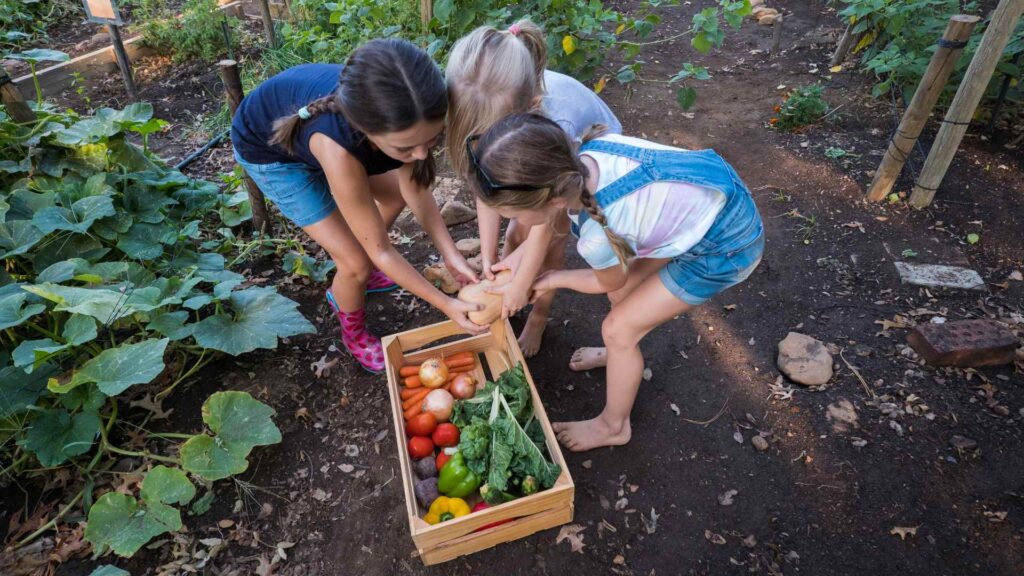
Gardening Activities for Kids
Creating a Garden Journal
- Tracking Growth and Progress: Encourage kids to keep a garden journal where they can record the growth of their plants. They can note the date of planting, watering schedule, and observations about how the plants are growing.
- Drawing and Writing About Plants: Let children draw pictures of their plants at different stages of growth. They can also write short descriptions or stories about their gardening adventures.
Fun Garden Crafts
- Painted Plant Markers: Get creative with DIY plant markers. Use popsicle sticks, stones, or old spoons, and let kids paint and decorate them to label different plants in the garden.
- DIY Garden Decorations: Make fun and colorful garden decorations like wind chimes, scarecrows, or garden flags. These crafts can add a personal touch to the garden and make it more engaging for kids.
Science Experiments in the Garden
- Observing Plant Growth: Conduct simple experiments to show how different conditions affect plant growth. For example, compare plants grown in the sun versus the shade, or with different amounts of water.
- Understanding the Water Cycle: Teach kids about the water cycle by showing how water evaporates, condenses, and precipitates. Use a clear plastic bag over a plant to demonstrate condensation and the formation of droplets.
- Learning About Pollinators: Explain the role of bees, butterflies, and other pollinators in the garden. Create a pollinator-friendly area with flowers that attract these beneficial insects.
These activities help make gardening a fun, educational, and interactive experience for kids, fostering a deeper connection with nature and a sense of accomplishment.
Troubleshooting and Tips
Common Gardening Problems
- Pests and How to Manage Them:
- Aphids: These tiny insects can be washed off with a strong spray of water or controlled using insecticidal soap.
- Slugs and Snails: Hand-pick these pests early in the morning or set up beer traps to attract and drown them.
- Caterpillars: Use organic sprays like Bt (Bacillus thuringiensis) or manually remove them from plants.
- Diseases and Prevention:
- Powdery Mildew: Prevent this fungal disease by ensuring good air circulation and avoiding overhead watering. Use neem oil or a baking soda spray as a treatment.
- Blight: Remove and destroy infected plant parts. Rotate crops each year to prevent soil-borne diseases.
- Root Rot: Ensure proper drainage to avoid waterlogged soil. Avoid overwatering and use well-draining soil mixes.
- Dealing with Poor Soil or Weather Issues:
- Amending Soil: Add organic matter like compost or aged manure to improve soil structure and fertility.
- Weather Extremes: Use mulch to retain moisture during dry periods and cover plants with frost cloths during unexpected cold snaps.
Tips for Success
- Encouraging Patience and Perseverance:
- Gardening teaches kids patience as they wait for their plants to grow. Celebrate small milestones and keep them engaged with regular garden visits and tasks.
- Making Gardening Fun and Rewarding:
- Turn gardening into a game by setting challenges, such as who can find the most worms or grow the biggest vegetable.
- Involve kids in every step, from planting seeds to harvesting and cooking, making the entire process a hands-on learning experience.
- Involving Kids in Every Step of the Process:
- Let kids choose which vegetables to plant and assign them specific tasks based on their age and abilities.
- Create a sense of ownership by giving each child their own garden plot or container to manage.
This section provides practical advice to address common gardening challenges, ensuring a smooth and enjoyable experience for both kids and parents.
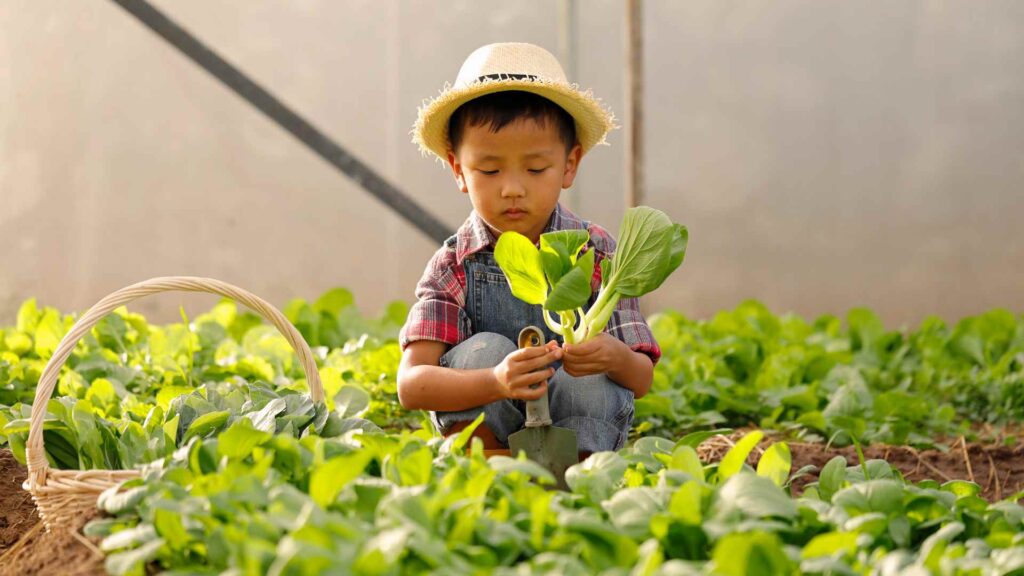
Harvesting and Enjoying the Bounty
When and How to Harvest Vegetables
- Signs That Veggies Are Ready to Pick:
- Radishes: Harvest when the roots are about 1 inch in diameter.
- Carrots: Ready when the tops are about 1 inch wide.
- Lettuce: Pick outer leaves as needed or harvest the whole head when it’s fully grown.
- Snap Peas: Harvest when the pods are plump but still tender.
- Tomatoes: Pick when fully colored and slightly soft to the touch.
- Zucchini: Best harvested when 6-8 inches long.
- Cucumbers: Ready when they reach 6-8 inches in length.
- Bush Beans: Pick young and tender beans for the best flavor.
- Bell Peppers: Harvest when they reach their full size and desired color.
- Safe Harvesting Techniques for Kids:
- Use small, child-friendly scissors or pruners for harvesting.
- Teach kids to hold the stem and cut carefully to avoid damaging the plant.
- Encourage gentle handling of vegetables to prevent bruising.
Cooking with Fresh Vegetables
- Simple, Kid-Friendly Recipes:
- Radish Butter Sandwiches: Spread butter on bread and top with thinly sliced radishes.
- Carrot Sticks with Hummus: Peel and cut carrots into sticks, and serve with hummus for dipping.
- Lettuce Wraps: Use large lettuce leaves to wrap up favorite fillings like chicken, cheese, and veggies.
- Snap Pea Stir-Fry: Quickly sauté snap peas with a little olive oil and a pinch of salt.
- Tomato Salad: Mix cherry tomatoes with mozzarella balls, basil, and a drizzle of olive oil.
- Zucchini Bread: Involve kids in grating zucchini and mixing ingredients for a delicious homemade bread.
- Cucumber Salad: Slice cucumbers and mix with a light vinaigrette for a refreshing side dish.
- Green Bean Almondine: Sauté beans with butter and sliced almonds for a tasty side.
- Stuffed Bell Peppers: Fill halved bell peppers with a mixture of rice, beans, and cheese, then bake.
- Teaching Kids to Cook and Enjoy Their Harvest:
- Encourage kids to wash and prepare vegetables.
- Let them help with simple cooking tasks like mixing, spreading, and arranging ingredients.
- Taste-testing is fun and educational; let kids sample veggies raw and cooked.
Sharing the Harvest
- Giving Vegetables to Friends and Family:
- Create small vegetable baskets as gifts.
- Encourage kids to share their gardening stories and experiences.
- Donating to Local Food Banks or Shelters:
- Teach kids the importance of community by donating excess produce.
- Research local organizations that accept fresh vegetable donations and involve kids in the process.
This section helps kids understand the joy of harvesting, the basics of cooking with fresh vegetables, and the value of sharing their bounty with others, making the gardening experience even more rewarding.
